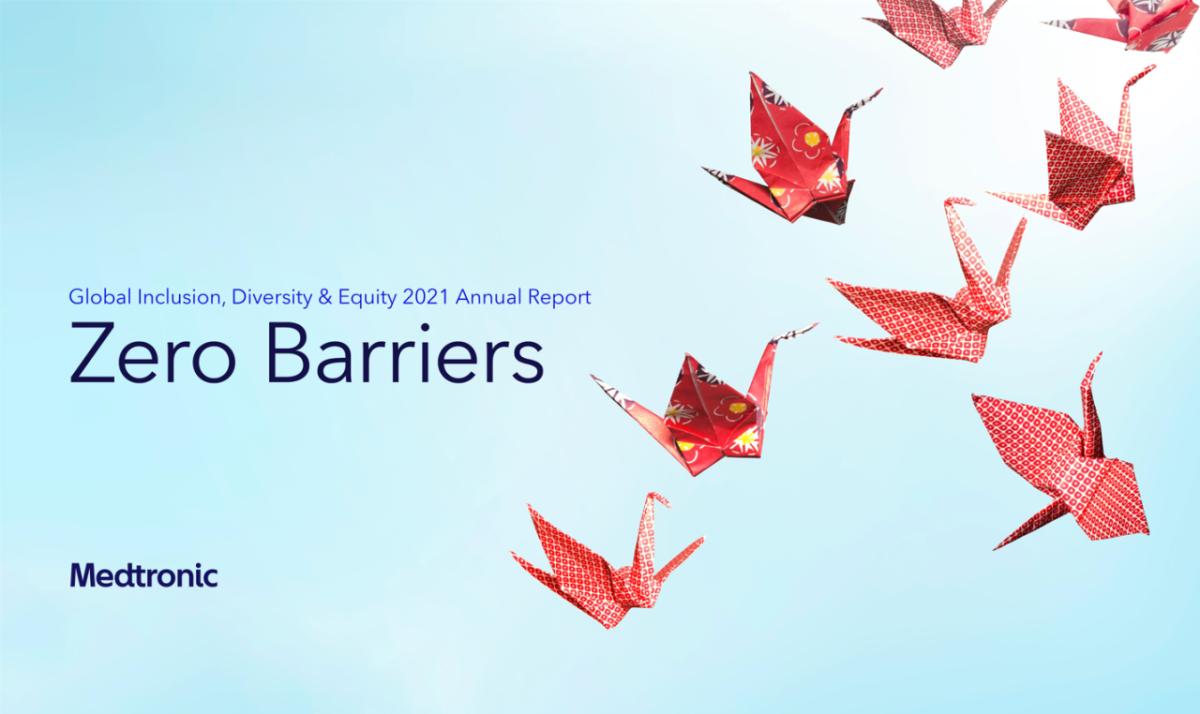Zero Barriers: How We Are Accelerating Our Progress
Excerpts from the 2021 Medtronic Inclusion, Diversity & Equity Report

Accelerating our progress
Accelerating the pace of change to advance inclusion, diversity and equity requires new approaches and ways of thinking. At Medtronic, we have taken several strategic actions to help us move faster toward zero barriers to equity. This includes shifting to a leader-led model for ID&E, building stronger accountability across our organization, setting new five-year organizational diversity representation goals, measuring beyond representation, and being even more transparent publicly about our progress.
Advancing to a leader-led model for inclusion, diversity and equity
Inside any organization, leaders are critical agents of change. When it comes to ID&E, holding leaders accountable for results can accelerate the pace of change.1
Many companies take a one-size-fits-all approach to holding leaders accountable: Eight out of 10 organizations set organization-wide ID&E goals and ask leaders to execute on them, according to recent Gartner research. But when ID&E goals are simply cascaded from the top, it creates a barrier. Leaders are less effective in driving progress in their business units and teams, the research shows. It’s because broad organizational goals often fail to address the specific and unique ID&E needs of each business unit.
At Medtronic, we are addressing this barrier by empowering our business leaders around the globe to drive meaningful, localized change in their parts of the organization. This approach calls on leaders to address the unique barriers in their organizations while also contributing to our companywide goals. We call this our “leader-led model” for ID&E. Starting in FY21, each vice president and above is responsible for developing an individualized plan to drive diverse representation and foster belonging on their teams — in ways that prioritize the unique needs and local context of their business, region or functions. And each leader is equipped with support to drive localized change that contributes to our broader organizational goals.
Tying executive compensation to ID&E and strengthening accountability
Many organizations prioritize leadership accountability for inclusion, diversity and equity. But research shows there are barriers in execution: In a recent Gartner survey, about 60% of organizations said leader accountability is the biggest obstacle to making progress in diversity and inclusion and only half of organizations said they were currently holding business leaders accountable for diversity and inclusion outcomes.2
At Medtronic, we are breaking down this barrier by creating meaningful incentives and governance processes for delivering ID&E results. It starts with the top leadership of our company.
In 2021, we tied annual incentive compensation for our top executives - our CEO, his team and their direct reports - to ID&E results. We did this to strengthen ID&E as a priority for senior leadership.
Our new model also supports Executive Committee members with a dedicated diversity business partner to support each team’s individual progress and address in real-time emerging challenges throughout the year.
Setting new representation goals for 2026
After achieving our previous representation goals set back in 2015, we have set new goals to accelerate diverse representation in management and above.
By fiscal year 2026, we aim for women to hold 45% of manager-and-above positions globally and people from ethnically diverse groups to hold 30% of manager-and-above positions in the U.S. Today, we are at 42% women in manager-and-above roles globally and 26% people from ethnically diverse groups in manager-and-above-roles in the U.S.
We will get there through a focus on inclusive hiring practices, career development and sponsorship programs for underrepresented talent, equitable talent management practices, leader accountability and more. Ultimately, we will not stop until we reach gender equity and equitably reflect market talent at all levels.
Measuring beyond representation
While diverse representation is important, we also know we won’t harness the power of our diversity if our employees don’t feel like they belong in our workplace. Companies that aren’t inclusive miss out on top talent: Research from McKinsey shows 39% of its global survey respondents said they have chosen to not pursue a job because of a perceived lack of inclusion.
What’s more, people from underrepresented groups are more likely to feel less included at work.3 And because inclusion and employee engagement are intertwined, it may leave them feeling less engaged in their work.
We aim to address these challenges by tracking employee engagement and inclusion scores against world-class benchmarks through annual surveys. We do this to identify where we can remove barriers for every Medtronic employee.
Read the full report here.
1) See Quereshi, Aliyah, Drive Leader Accountability by Setting Relevant, Actionable DEI Goals, Gartner, September 3, 2021.
2) See Quereshi, Aliyah, Drive Leader Accountability by Setting Relevant, Actionable DEI Goals, Gartner, September 3, 2021.
3) See Bailinson, Peter; Decherd, William; Ellsworth, Diana; Guttman, Maital, Understanding organizational barriers to a more inclusive workplace, McKinsey, 2020.

